The AMD Trinity Review (A10-4600M): A New Hope
by Jarred Walton on May 15, 2012 12:00 AM ESTAMD Trinity Gaming Performance
After the 3DMark results, you might be wondering if Intel has finally caught up to AMD in terms of integrated graphics performance. The answer is…yes and no. Depending on the game, there are times where a fast Ivy Bridge CPU with HD 4000 will actually beat out Trinity; there are also times where Intel’s IGP really struggles to keep pace. The good news is that at least everyone is now onboard the DX11 bandwagon, and compatibility with games has improved yet again for Intel. Here are our “Value” benchmark results for seven recent games; we’ll have more information in a moment.

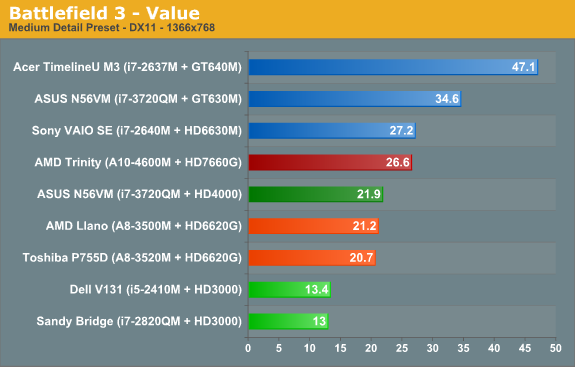
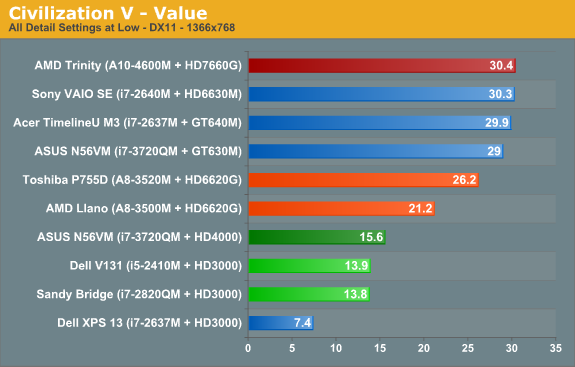

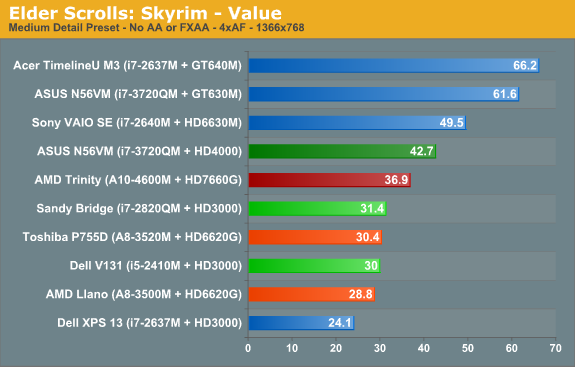
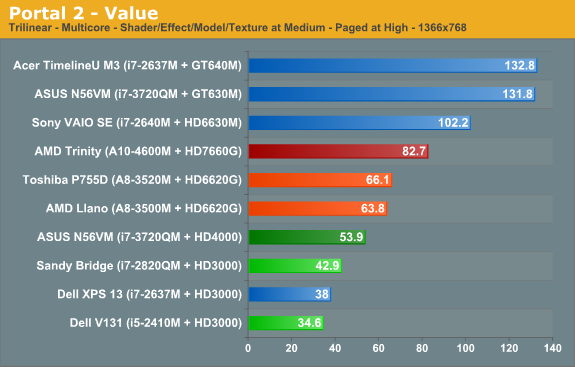
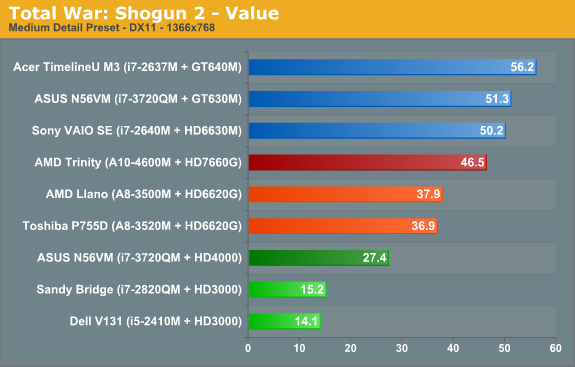
Out of our seven test titles, AMD’s Trinity leads any other IGP in four titles by a large margin. The other three titles actually have Ivy Bridge slightly ahead of Trinity, but the gaps aren’t nearly as big. Overall, the average performance across the seven games at our Value (medium) settings has AMD’s Trinity A10-4600M leading Intel’s i7-3720QM by 21%, and if we look at quad-core Sandy Bridge with HD 3000 (i7-2820QM) Trinity is 72% faster. Trinity is also around 20% faster than 35W Llano on average.
Let’s expand our gaming suite just a bit to see if things change, though. Just like we did with Ivy Bridge, we ran the eight games in our previous benchmark suite at medium detail settings. We can then compare performance across a wider 15 title selection to see how Trinity matches up against HD 4000, HD 3000, and HD 6620G (Llano). We’ll start with the bottom (HD 3000/Sandy Bridge) and move up.
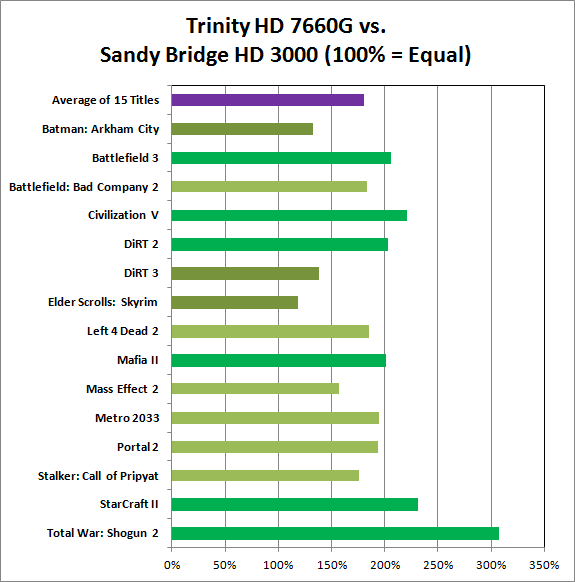
Llano’s HD 6620G was already faster than HD 3000, and Trinity’s HD 7660G is faster than Llano, so the Sandy Bridge gaming matchup is a landslide victory in AMD’s favor. The closest Intel can get is in the same three titles where Ivy Bridge leads Trinity: Batman: Arkham City, DiRT 3, and Skyrim. Here, however, HD 3000 can’t actually close the gap and HD 6620G is at least 20% faster than HD 3000, with an average performance improvement of nearly 80%.
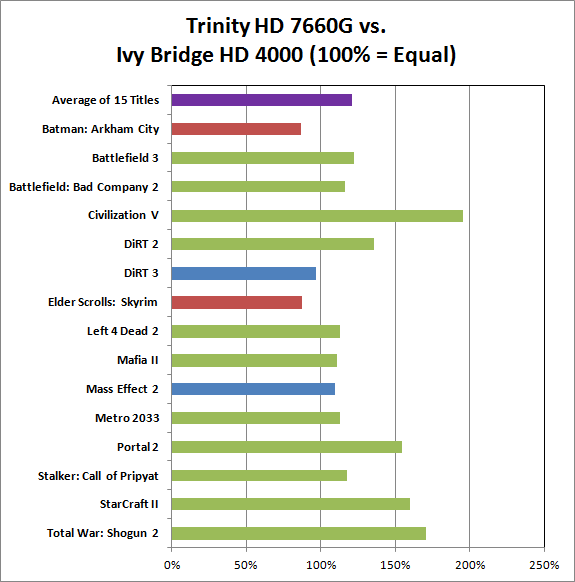
We found that across the same selection of 15 titles, Ivy Bridge and Llano actually ended up “tied”—Intel led in some games, AMD in others, but on average the two IGPs offered similar performance. This chart and the next chart will thus show a similar average increase in performance for Trinity, but the details in specific games are going to be different. Starting with Ivy Bridge and HD 4000, as with our earlier game charts we see there are some titles where Intel leads (Batman and Skyrim), a couple ties (DiRT 3 and Mass Effect 2), and the remainder of the games are faster on Trinity. Mafia II is close to our <10% “tie” range but comes in just above that mark, as do Left 4 Dead 2 and Metro 2033. The biggest gap is Civilization V, where Intel’s various IGPs have never managed good performance; Trinity is nearly twice as fast as Ivy Bridge in that title. Overall, it's a 20% lead for Trinity vs. quad-core Ivy Bridge.
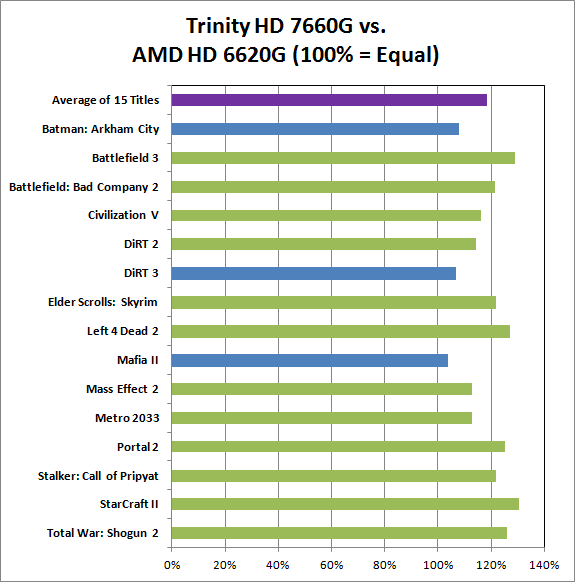
Against Llano, Trinity is universally faster, but the smallest gap is in Mafia II (3%) while the largest gap is in StarCraft II (30%). On average, looking at these games Trinity is only 18% faster than Llano. What’s not entirely clear from the above chart is whether we’re hitting CPU limitations, memory bandwidth limitations (remember that Llano and Trinity share bandwidth with the rest of the system), or perhaps both. At our chosen settings, what is clear is that Trinity’s “up to 56% faster” graphics never make it that high.
We saw 35-45% higher scores in 3DMark 11 and Vantage, which tend to remove the CPU from the equation more than actual games, so our guess would be that if AMD continues with their APU plan they’re going to need to work more on the CPU side of the equation. We also see the same thing looking at the VAIO SE scores in the earlier gaming charts: the HD 6630M scores are 20% faster on average, but much of that appears to come from the faster CPU rather than the GPU.










271 Comments
View All Comments
CeriseCogburn - Thursday, May 24, 2012 - link
And thus anyone who has a laptop already and especially anyone with an old Optimus has no need to spend $700 or $800 on a trinity laptop - just a few bucks on some ram.If they have a lower end MXM discrete they can just upgrade that and not have the hassles of setting up another whole system and spending days transferring data and configuring and then crossing their fingers the amd trinity doesn't glitch out.
We can also forget any sort of "future proofing" with the trinity, unlike the optimus systems or any discrete laptop, many available for a couple hundred less now because their core 2 processors are considered "old" but thanks to you brilliant amd fans we now know it doesn't matter at all might as well get a real laptop gaming machine.
Thanks for the hot tips.
BSMonitor - Tuesday, May 15, 2012 - link
Sure it is. If you browse Flash enhanced, Java runtime pages, Adobe Reader embedded, etc.. Do that and be working in a Java runtime software package, Visual Studio, Office App with a bunch of the fancy tables and drawing tools.It is NOT enough CPU. I would not tolerate it.
Taft12 - Tuesday, May 15, 2012 - link
OK you win. You've convinced us that Trinity is too slow for 1% of users.In other words, you've convinced us that this product is a winner. I just knew you were an AMD fanboi at heart!
Spunjji - Wednesday, May 16, 2012 - link
LOLmedi01 - Thursday, May 17, 2012 - link
Minimized Visual Studio NEEDS NO CPU POWER.Inactive Adobe Reader "embedded" NEEDS NO CPU POWER.
Inactive Office App with tables and what not NEEDS NO CPU POWER.
Miraculous "Java runtime software package" as well as flash would only consume more than a tiny bit of CPU only if it was written by drunken monkeys.
RAM is what you need when multitasking. A lot of it.
And fast HDD.
Slapping SSD hard drive into your pc/notebook would speed mentioned things up tremendously. Faster CPU would not.
kshong - Tuesday, May 15, 2012 - link
I have read many of your comments on AMD and Intel and I have a slight suspicion that you're a hard-to-please person.Spunjji - Tuesday, May 15, 2012 - link
That was putting it kindly. ;)BSMonitor - Tuesday, May 15, 2012 - link
Should I expect a brand new PC to behave like one from 6 years ago for some applications??Spunjji - Wednesday, May 16, 2012 - link
Thing is, it doesn't. Thus your argument fails.Good day to you, sir! :D
mikato - Wednesday, May 16, 2012 - link
Spunjji - Anandtech comments area would like to hire you as the new BS Monitor! We had a problem with the old one.